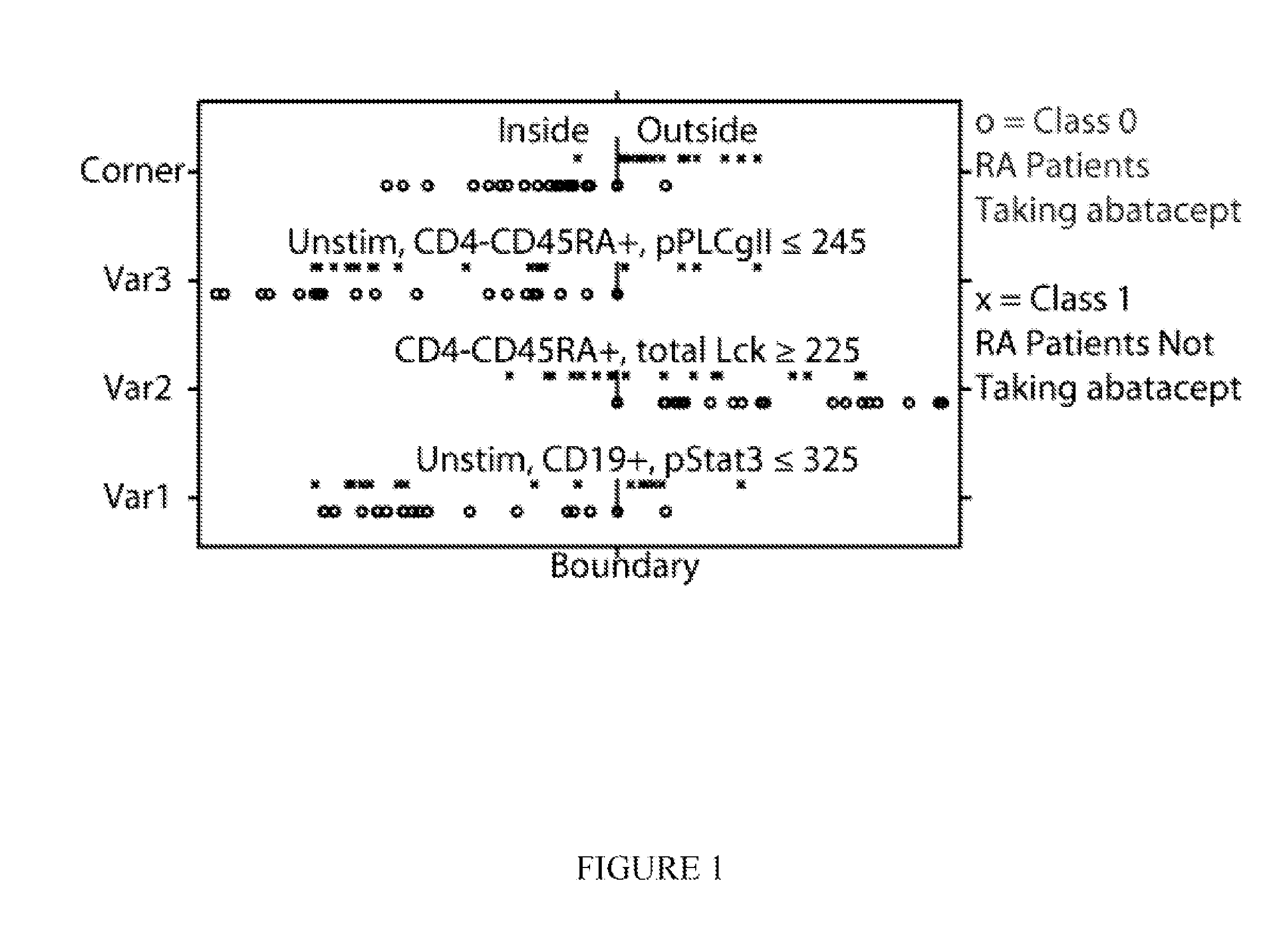Methods for autoimmune disease diagnosis, prognosis, and treatment`
- Summary
- Abstract
- Description
- Claims
- Application Information
AI Technical Summary
Benefits of technology
Problems solved by technology
Method used
Image
Examples
example 1
Monitoring Disease Activity in Rheumatoid Arthritis
[0264]A blood draw of 5 mL to 10 mL was collected from a subject. Within four hours, the blood was ficoll-prepared to isolate the leukocytes (usually 5 to 10 million cells) from the erythrocytes and other blood cells. The leukocytes were cryopreserved in 90% fetal calf serum (FCS), 10% dimethyl sulfoxide (DMSO). A subject's sample was later thawed at 37° C. and washed twice with media (RPMI with 5% FCS). Alternatively, the cells can be used fresh without freezing. The cells were allowed to recover at 37° C. for 1 hour. The cells were aliquoted at 0.5 to 1 million cells and exposed to modulator (i.e. stimulated) for 5 to 15 minutes at 37° C. Exposure to modulator can include the use of any of the described modulators, and were performed at saturating dosages (eg. 50 ng / mL). Stimulation of B cell receptor (BCR) was performed by the addition of anti-IgG, anti-IgM, anti-kappa, and anti-lambda (BD Biosciences) at 10 ug / mL for 15 minutes....
example 2
Classifying Subjects with Rheumatoid Arthritis by Therapeutic Regimen
[0269]The invention can be used as a tool by drug development companies to better understand the molecular mechanisms, or mode of action, of a specific drug. In this example, the invention was used to investigate the drugs prednisone and Orencia (Abatacept). Samples were collected and processed similarly as in Example 1. A study of 39 female RA patients, roughly half taking Orencia, demonstrated that specific cellular features were enriched in the treated group. The classifier Orencia-1 was defined by the combination of nodes [phospho-Stat3 MFI, basal, B cells], [Lck MFI, total protein, CD8+ naive T cells], [phospho-PLCγ2 MFI, basal, CD8+ T cells]. The model correctly predicted 20 of 21 treated subjects with only one false positive. A bagging / bootstrapping cross-validation confirmed the predictive power of this classifier. In effect, the model shows that Orencia predisposes patients to having lower basal activated ...
example 3
Predicting Changes In Disease Activity
[0272]Disease activity in systemic lupus erythematosis (SLE) is often expressed in terms of the Systemic Lupus Erythematosus Disease Activity Index (SLEDAI) and / or the Physician Global Assessment (PGA). Using these measures, and samples collected from subjects at multiple times, it was demonstrated that methods of the invention can identify nodes that objectively predict levels of increased disease activity (e.g. flares) at least 90 days in advance. Blood samples were collected from patients at two times, separated by 90 days, and disease activity was scored at each time point. Samples were processed similarly as in Example 1. Modulation, activation level determination, and analysis were performed as described herein. For some of the signaling nodes, signaling responses to certain stimulations in certain cell types was higher in patients that exhibited an increase in disease activity, and included [Stat3, IL4, B cells], [Stat1, IL10, CD4−CD45RA+...
PUM
| Property | Measurement | Unit |
|---|---|---|
| Mass | aaaaa | aaaaa |
| Absorption cross section | aaaaa | aaaaa |
| Therapeutic | aaaaa | aaaaa |
Abstract
Description
Claims
Application Information
 Login to View More
Login to View More - R&D
- Intellectual Property
- Life Sciences
- Materials
- Tech Scout
- Unparalleled Data Quality
- Higher Quality Content
- 60% Fewer Hallucinations
Browse by: Latest US Patents, China's latest patents, Technical Efficacy Thesaurus, Application Domain, Technology Topic, Popular Technical Reports.
© 2025 PatSnap. All rights reserved.Legal|Privacy policy|Modern Slavery Act Transparency Statement|Sitemap|About US| Contact US: help@patsnap.com


